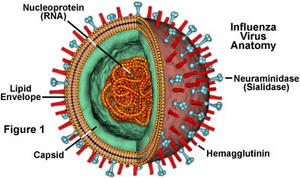Chemistry professor's research paves way for flu treatments
New research by a Florida State University chemistry professor uses some of the world’s most powerful magnets to put a bulls-eye on the flu virus.

“We really don’t know when a deadly flu epidemic is going to hit next," said FSU Professor of Chemistry and Biochemistry Tim Cross. "We need backup to vaccines.”
Led by Professor Tim Cross of FSU's Department of Chemistry and Biochemistry and his team at the Florida State University-based National High Magnetic Field Laboratory (MagLab), scientists delved into the complexities of exactly how the flu virus works and why it’s so effective at making people so sick. With a better understanding of how it works, researchers will now be able to turn their attention to creating more effective prescription drugs to fight the flu.
Cross and his team were able to detail the mechanism that activates the flu virus, permitting it to reproduce in a human cell. They laid out their findings in the academic journal Structure.
“If we can get a drug that disrupts this mechanism, that would be huge,” Cross said. “We really don’t know when a deadly flu epidemic is going to hit next. We need backup to vaccines.”
But to create those drugs, scientists needed to first understand how the virus functions on its most basic level.
The influenza virus is what’s known as an enveloped virus, meaning it has a membrane coat, similar to the way a cell has a membrane. In that membrane are three different proteins, one of which is called the M2 proton channel.

The structure of the influenza virus is somewhat variable, but the virion particles are usually spherical or ovoid in shape and 80 to 120 nanometers in diameter.
As the virus moves into a cell, it enters an acidic environment, which activates the M2 proton channel. Once the M2 proton channel is activated, protons move through the channel and compel the membrane coat to fuse to the host membrane, causing infection and ultimately, reproduction of the virus.
Using the MagLab’s most sensitive nuclear magnetic resonance magnet — essentially a super powered MRI — scientists were able to get a clear image of the channel and how protons moved through it causing the fusion of the virus with the host membranes.
“We can actually see the protons move,” Cross said. “Nobody thought we would be able to do this.”
For years, scientists worldwide have been fixated on how this channel works because it provides the basic clues to understanding how viral infection works. The M2 channel has long been a target of drug developers, but when the swine flu broke out in 2009, doctors quickly discovered that drugs that had been in use for decades suddenly didn’t work.
“The drugs didn’t work anymore,” Cross said. “As in so many cases, the virus had evolved. So there’s a lot of interest in studying this protein and seeing if we can develop a new antibiotic.”
Cross’ work was funded by the National Institutes of Health and the National Science Foundation.
The paper’s co-authors are FSU Professor of Physics Huan-Xiang Zhou, MagLab scientist Riqiang Fu and former FSU graduate student Yimin Miao.

